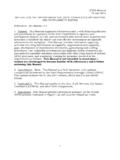Transcription of A Fragmented Approach To CRM - …
1 All rights reserved GSP & Associates, LLC 2000 A Fragmented Approach To CRM: An Oxymoron? By Glen S. Petersen A Fragmented Approach to CRM: An Oxymoron? All rights reserved One Community, Inc. 2000 2 Introduction Many organizations find themselves in the position of having an obvious problem (opportunity) in one area of customer relationship management (CRM) and fund a project to fix it. However, when the empowered (go make it so) manager proceeds to find a suitable solution he is confronted with an industry that has more messages than Heinz has products.
2 From a product standpoint, it is likely with today s capabilities, that there exists software that addresses the issue at hand. At the same time, that manager is likely to be confronted with messages that espouse the need to seek a more pervasive or integrated solution. So what s wrong with fixing what s broken and getting on with things? Well perhaps nothing or perhaps everything. Perhaps , as used in this context can have a very large implication and the issue is, do we know what we are trading-off by taking this Approach ? In this scenario, neither the manager nor the organization can answer that question.
3 As the title implies, if the organization could answer the question, it is unlikely that it would be pursing a Fragmented Approach and taking the argument further, fragmentation and CRM form an oxymoron. The rationale for this contention is outlined below. Definitions Both the CRM industry and management literature are filled with many vaguely defined terms; therefore, it is reasonable to start the discussion with some definitions. The reader should be aware that there is general agreement in the industry regarding the nature of this terminology, but definitions often reflect various biases including the writer s.
4 1. CRM represents Internet based Customer Relationship Management. From a technology component standpoint, CRM includes the following applications: Marketing Automation Sales Automation Call Center Data Warehouse (repository) Web capabilities 2. CRM has both long and short definitions, however, most definitions recognize two intertwined concepts: CRM is a business strategy that commits the organization to a growth objective achievable through customer centric action (delivery of value). Technology is viewed as an enabler that allows the organization to extend its infrastructure to partners and customers in a manner that enhances value to these respective groups in a cost effective manner.
5 3. A Fragmented Approach is assumed to be one where each functional group independently implements their portion of the CRM (absent of a unifying vision or strategy). 4. An Integrated Approach is assumed to be one where there is a system vision that matches the goals and capabilities ascribed by the organization s business strategy. Given these definitions, we will now explore the implications of the two approaches. A Fragmented Approach to CRM: An Oxymoron? All rights reserved One Community, Inc. 2000 3 The Value Delivery Issue Placing product and risk attributes aside for a moment, communication and service (the other dimensions of value) are delivered through processes.
6 The majority of these processes involves multiple hand-offs and cross functional lines. For example: Lead management Collateral fulfillment Proposal generation Order entry and pricing Order fulfillment Order shipment and tracking Call center escalation and reporting Leveraging these and other value impact processes is going to be difficult to achieve if they are an afterthought or require complex integration capabilities. The Alignment Issue Further exacerbating the process issue is the non-alignment of functional goals and performance criteria.
7 These reporting techniques are designed to influence behavior; so if the criteria lack alignment, the organization will not be pulling in the same direction from a customer value delivery perspective. To demonstrate this, consider the following: Sales The sales organization is typically revenue driven with minimal emphasis on mix or customer profitability. Quotas often drive discounting and other artificial actions that dilute perceived value and may actually reduce delivered value to the customer. Marketing Below the vice president level, there is typically a brand orientation that often has minimal focus on the bundling of capabilities and/or the provision of a total customer solution.
8 At lower levels, the focus often centers on programs, campaigns, and leads where the quantity as opposed to the quality of the response is the driver. Again, this focus can result in a dilution of value and in fact invite churn. Customer Service Service is often viewed as a cost to be minimized as opposed to a value that should be maximized. Minimization tends to focus on productivity measures that in essence are focused on cost containment. Thus the up-side potential tends to get lost in the equation. e-Commerce e-Commerce represents a distribution channel.
9 The question is, how does it integrate with existing channels and how does it address customer value needs? Can or should a customer be able to order something on the web and expect to receive order status information from customer service? What metrics represent success? Information It is common for the IS organization to be measured by a number of metrics A Fragmented Approach to CRM: An Oxymoron? All rights reserved One Community, Inc. 2000 4 Services that relate to cost containment and project related metrics such as on -budget and on-time. As outlined, it should be clear that the major functions that comprise CRM do not have a common customer focus, at best, they may share a customer satisfaction goal; but how does this translate into action or accountability?
10 Systems and Economics It is hard to envision that, for a given level of functionality that a Fragmented Approach will result in a superior cost of ownership. However, even if this were the case, CRM is about delivering value and demand creation, not cost minimization. Timing There is an old and unfortunately all too true adage that there is never time to do things right the first time but always time to do them over. If functional departments are experiencing pain and not meeting MBOs; it is going to be difficult to convince them that delay of any type or reason is acceptable.






